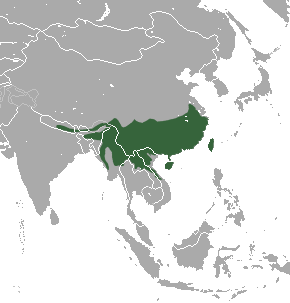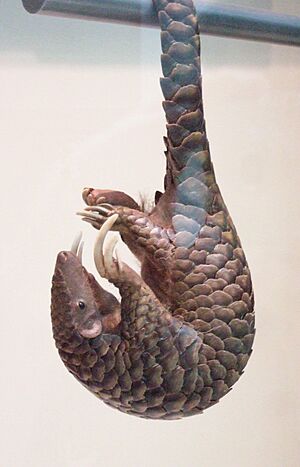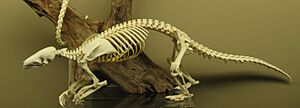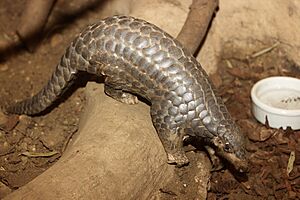Chinese pangolin facts for kids
Quick facts for kids Chinese pangolin |
|
|---|---|
 |
|
| Conservation status | |
| Scientific classification | |
| Genus: |
Manis
|
| Species: |
pentadactyla
|
| Subspecies | |
|
See text |
|
 |
|
| Chinese pangolin range | |
The Chinese pangolin (scientific name: Manis pentadactyla) is a special animal found in parts of Asia. It lives in the northern Indian subcontinent, northern Southeast Asia, and southern China. Sadly, the Chinese pangolin is now listed as Critically Endangered. This means it is at a very high risk of disappearing forever.
Scientists believe that over 80% of these pangolins have vanished in the last 21 years. The main reason for this is poaching, which is illegal hunting. People hunt them for their meat and scales, which are used in some traditional medicines.
Contents
What They Look Like


The Chinese pangolin looks a bit like a scaly anteater. Its scales are usually a grayish-blue color. Its body and head are about 40 to 58 centimeters (16 to 23 inches) long. Its tail adds another 25 to 38 centimeters (9.8 to 15 inches).
An adult Chinese pangolin usually weighs between 2 and 7 kilograms (4.4 to 15.4 pounds). It has 18 rows of scales that overlap, and it also has hair, which is rare for a mammal with scales. It has a small, narrow mouth and a tiny, pointed head. Its claws grow longer as it gets older.
Female pangolins usually give birth to one baby at a time. A newborn pangolin weighs about 93 grams (3.3 ounces) and is about 45 centimeters (18 inches) long. Chinese pangolins have their babies in April and May when the weather gets warmer. The babies are born with soft scales, which become hard after just two days.
Even though a baby pangolin can walk on its first day, its mother often carries it on her back or tail. If the mother senses danger, she quickly curls her baby onto her belly using her tail to keep it safe. Sometimes, male pangolins let the mother and baby share their burrow.
Scientific Names
The scientific name Manis pentadactyla was first given to the Chinese pangolin by Carl Linnaeus in 1758. Over the years, scientists have found different types of Chinese pangolins. These are called subspecies:
- Manis pentadactyla auritus was found in mainland Asia.
- Manis pentadactyla pentadactyla was found in Taiwan.
- Manis pentadactyla pusilla was found on Hainan island.
Where They Live
The Chinese pangolin lives in several countries in Asia. These include southern Nepal, northeast India, Bhutan, Bangladesh, Myanmar, northern Indochina, and southern China. They also live on the island of Hainan and most of Taiwan. They can be found in places as high as 3,000 meters (9,800 feet) up mountains.
They used to live in many more parts of China, even north of the Yangtze River. Today, confirmed groups of Chinese pangolins are found in provinces like Yunnan, Hainan, Guangxi, and Guangdong. They make their homes in many different types of forests, like tropical forests and bamboo forests. They can also live near agricultural fields and grasslands.
How They Behave
The Chinese pangolin is a very private animal that is active mostly at night. It moves slowly. Its hard scales act like a shield to protect it from animals that might try to eat it. When it feels scared, it curls up into a tight ball. This protects its soft belly and face.
What They Eat
Chinese pangolins mainly eat insects, especially termites and ants. They use their big front claws to dig into ant nests and termite mounds. Then, they use their long, sticky tongue to catch the insects. They also dig long burrows in the ground, which they use for sleeping and finding termites.
Scientists once studied the stomach of a young pangolin. They found it had eaten over 25,000 ants and 800 termites. This shows how much they rely on these insects for food.
It is very hard to feed pangolins in zoos because they have such a special diet. Many pangolins kept in zoos in the past did not live very long. This was often because they didn't like the food they were given and had trouble digesting it. Zoos are now trying new food recipes to help these animals stay healthy.
Why They Are in Danger
The biggest danger to the Chinese pangolin is poaching. This means people hunt them illegally. Some people in China eat their meat. Their scales are also used in traditional Chinese medicine (TCM). In the 1960s, a huge number of Chinese pangolins were caught each year.
In 2002, an international agreement called CITES made it illegal to sell pangolins across country borders. Even though China has laws to protect pangolins, it might not be enough to save them. CITES reports that pangolins are the most illegally traded mammal in the world.
Chinese pangolin scales are sold to treat many different health problems, like cancer or stomach issues. Other parts of their body are also used in traditional medicine. However, many traditional medicine experts now believe that other ingredients could be used instead of pangolin scales. Some local people in eastern Nepal even think pangolin scales bring good luck.
Even though pangolins have been protected by laws since the 1970s, people still hunt these endangered animals. In 2014, officials in Hong Kong found scales from nearly 8,000 pangolins in one illegal shipment. Just two weeks later, they found another shipment with scales from about 5,000 pangolins. These discoveries show how serious the problem of illegal trade is.
Protecting Them
In 2016, CITES changed the Chinese pangolin's protection status. It moved the species to Appendix I. This means it is now among the animals most directly threatened with extinction. Appendix I stops all commercial trade of wild-caught pangolins. Many countries where pangolins live have also passed laws to protect them:
- In 1972, India fully protected the Chinese pangolin.
- In 1973, Nepal made it a protected animal.
- In 1976, Hong Kong passed a law to protect endangered species, including the pangolin.
- In 1989, China classified the species as protected.
- In 1990, Taiwan protected all types of pangolins.
- In 1992, China made its protection laws stronger. Thailand also protected pangolins that year.
- In 1994, Myanmar fully protected the species.
- In 2000, China set clearer punishments for crimes involving pangolins.
- In 2006, China made new rules to follow CITES guidelines. Hong Kong also increased its protection. Vietnam classified it as fully protected.
- In 2007, China stopped giving out licenses to hunt pangolins. They also made rules for how pangolin scales could be traded. Laos declared the species near extinction.
- In 2012, Bangladesh protected the Chinese pangolin.
- In 2020, China raised the protection status of all pangolin species to the highest level.
China has passed many laws to protect pangolins because their numbers have dropped so much there. This is mainly due to the extreme hunting for their scales and meat.
What Else Is Being Done
In May 2016, a survey showed that over 80% of adults in China want pangolins to be protected. This shows that many people care about these animals.
A group of experts called the IUCN SSC Pangolin Specialist Group suggested ways to help pangolins. Their ideas include:
- Watching pangolin populations more closely.
- Finding out how many pangolin products are being used.
- Using DNA analysis to learn more about different pangolin groups.
- Finding safe places for pangolins to live.
The plan also aims to increase patrols in areas where pangolins live. It wants to teach more people about the problem and, most importantly, reduce the demand for pangolin meat and scales.
Some researchers suggest giving rewards, like money, to local communities. This would encourage them to help protect pangolins. Others think it's important to find other ingredients for traditional medicines that can replace pangolin scales.
The China Biodiversity Conservation and Green Development Foundation (CBCGDF) is a group that actively works to save Chinese pangolins. They do research and collect information in the wild. Since 2017, they have set up three special areas in China to help protect pangolins.
In 2017, the CBCGDF rescued 33 Chinese pangolins from illegal hunters. They released them to a wildlife rescue center. However, only 14 of these pangolins survived. The CBCGDF also asked for pangolin scales to be removed from the Traditional Chinese Medicine Book. They also called for burning illegally traded pangolin scales.
See also
- List of mammals in Hong Kong
- List of mammals in Taiwan



